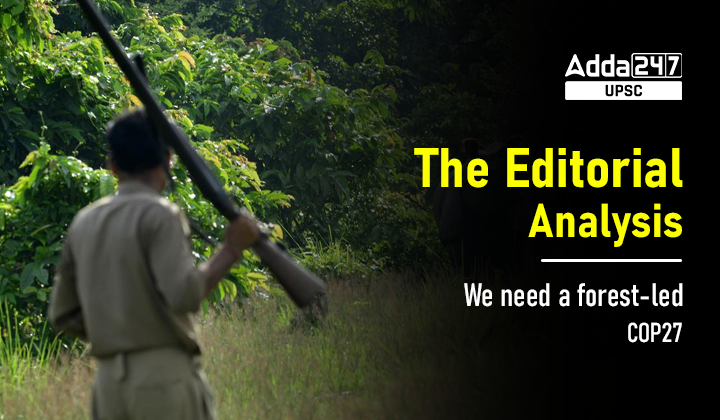Table of Contents
We Need a Forest-led COP27- Relevance for UPSC Exam
- GS Paper 3: Environment- Conservation, environmental pollution and degradation.
UNFCCC COP 27 in News
- In September, a study published in the journal Science said earth may have already passed through five dangerous tipping points due to the 1.1°C of global heating caused by humanity to date.
Role of Technology in countering Climate Change
- Demand for Transfer of Technology: Calls for developing and transferring technologies to support action on climate change have become louder worldwide.
- Overdependence on Technology: Technology has become a survival strategy for our species, but the degree of techno-determinism that exists in the strategy to reverse climate change is alarming.
- Technology alone is unprepared to deal with the challenge, which requires a societal overhaul and a zero emission strategy.
- History is on the side of technological innovation. Norman Borlaug, for instance, ushered in the Green Revolution, which fed billions of people and increased yields.
- But we may need a few million climate Borlaugs to tackle the problems staring at us.
Technological Optimism in UNFCCC COP 26
- COP26 at Glasgow also fuelled technological optimism. There was an observation that every technological solution discussed at COP26 depends on just three resources:
- Nelectricity (non-emitting electricity generated by hydropower, renewables or nuclear fission),
- Carbon capture and Storage (CCS) or
- Biomass
- Nelectricity: We currently have 4kWh/day of nelectricity per person. But the COP26 plans require 32 (range 16-48).
- Carbon capture and Storage (CCS): We currently have 6kg of CCS per person per year, but the COP26 plans require 3,600 (range 1,400-5,700).
- Biomass: We eat 100kg plant-based food per person each year, but producing enough bio-kerosene to fly at today’s levels requires 200kg of additional harvest.
Associated Concerns with Technological Optimism
- Tech-centric mitigation conversations leave forest economies and subjects such as conservation and forests, which are the best carbon removal instruments, to the ideological fringes of climate conversation.
- The total demand for those resources required by the plans discussed at COP26 cannot be met by 2050.
- There is no possibility that our supplies of these will be near the levels required by the plans discussed at COP26.
Role Forests in Countering Climate Change
- Forests are home to 80% of terrestrial wildlife. They are at the intersection of the climate change crisis and the biodiversity crisis.
- Hence, forests are best suited to help in countering our fight against climate change.
- Forests absorb a net 7.6 billion metric tonnes of CO2 a year. A new study has found that their biophysical aspects have a tendency to cool the earth by an additional 0.5%.
- The conservation of forests, along with other nature-based solutions, can provide up to 37% of the emissions reductions needed to tackle climate change.
- The Dasgupta Review-Independent Review on the Economics of Biodiversity reports that green infrastructure (salt marshes and mangroves) are 2-5 times cheaper than grey infrastructure (breakwaters).
- Another study estimated that the annual gross carbon emissions from tropical tree cover loss between 2015 and 2017 was equivalent to 4.8 billion tonnes.
- This causes more emissions each year than 85 million cars do in their lifetime.
- In 2019, approximately 34% of total net anthropogenic greenhouse gas emissions came from the energy supply sector, 24% from industry, 22% from agriculture, forestry and other land use, 15% from transport and 6% from buildings.
Way Forward
- The IPCC Land Report estimates that land serves as a large CO2 sink.
- There is a growing body of evidence that a large proportion of the required removals could be achieved by conserving natural sinks, improving biodiversity protection, and restoring ecosystems.
- Preserving earth’s cyclical processes by protecting terrestrial ecosystems and natural sinks and transformative agricultural practices under the leadership of indigenous people.
- Local communities is a far more equitable and cost-effective way of tackling the climate crisis than it is being done now.
Conclusion
- We need to realise that the climate crisis is just a symptom; our real problem is that human consumption and activity have exceeded the regenerative capacity of our planet.
- Technology, at best, can assist us, not lead us, on the pathway to a sustainable, regenerative and equitable world.
COP26 Glasgow Summit of UNFCC- India’s Commitments



 TSPSC Group 1 Question Paper 2024, Downl...
TSPSC Group 1 Question Paper 2024, Downl...
 TSPSC Group 1 Answer key 2024 Out, Downl...
TSPSC Group 1 Answer key 2024 Out, Downl...
 UPSC Prelims 2024 Question Paper, Downlo...
UPSC Prelims 2024 Question Paper, Downlo...





